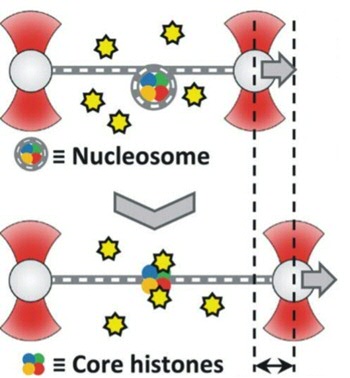Optical Tweezers maakt de dynamica van histoon-DNA interacties zichtbaar
Samen met onderzoekers uit Sevilla heeft de groep van Wouter Roos geavanceerde microscopietechieken gebruikt om chromatine functie te bestuderen. Met behulp van een optisch pincet (optical tweezers) hebben de onderzoekers laten zien hoe de interacties van histonen met DNA - chromatine genaamd - door andere eiwitten wordt beïnvloed. De resultaten zijn gepubliceerd in het tijdschrift Advanced Science.

Het DNA met daaraan verbonden eiwitten wordt chromatine genoemd. Dit bevindt zich in de celkern. Chromatine wordt gemaakt door het DNA om nucleosomen te wikkelen. Dit zijn eiwitcomplexen die bestaan uit 8 histonen. Voor het aflezen van het DNA, moet het DNA van de nucleosomen worden afgerold en later wordt het weer opgerold, zodat het compact kan worden opgeborgen in de celkern. In dit onderzoek is dit op- en afrollen onderzocht en in het bijzonder hoe de interactie met enkele histonen en hulpeiwitten plaatsvindt.
De groep van Roos heeft hiervoor een optisch pincet (optical tweezers) gebruikt. Hiermee kan met behulp van licht een enkel DNA molecuul worden “opgehangen” in de vloeistof en je kan live zien hoe het DNA interacties aangaat met de histonen, hulpeiwitten en hoe nucleosomen worden gevormd. Met deze enkele-molecuul techniek hebben de onderzoekers laten zien dat heel verschillende hulpeiwitten, de chaperonnes SET/TAF-1β en Nucleofosmine-1, toch op dezelfde manier binden aan de histonen en blijkbaar op een vergelijkbare manier hun functie uitoefenen. Verder is een ander eiwit bestudeerd, cytochrome-c. Dit eiwit moduleert de manier waarop de hulpeiwitten de histonen van het DNA pulken en daarmee dit proces reguleren. De resultaten geven een verrassend gedetailleerde blik op de activiteit van de bestudeerde eiwitten en leveren nieuwe inzichten op over de regulatie van het proces van DNA aflezen en oprollen rondom histonen.
Publicatie:
Pedro Buzón, Alejandro Velázquez-Cruz, Laura Corrales-Guerrero, Antonio Díaz-Quintana, Irene Díaz-Moreno, Wouter H. Roos
The histone chaperones SET/TAF-1β and NPM1 exhibit conserved functionality in nucleosome remodelling and histone eviction in a cytochrome c-dependent manner
Advanced Science (2023) 2301859, https://doi.org/10.1002/advs.202301859
Meer info over het Roos lab:
https://www.rug.nl/research/zernike/molecular-biophysics/roos-group/
